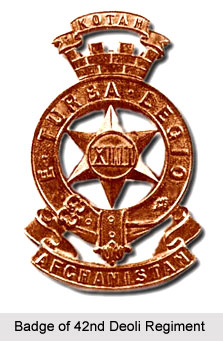 The 42nd Deoli Regiment was one of the infantry regiments of the British Indian Army. The battalion provided service in existence from the year 1857 to 1921. The battalion was a part of the Bengal Army and was developed by the British East India Company during 1857. The army unit was also incorporated as a part of the Bengal Command. The army of the province of Bengal was the armed forces of Bengal Presidency and was amongst the 3 main Presidency Armies in British India. The British Presidency Armies belonged to the British East India Company until the Sepoy Mutiny of 1857. The Government of India Act 1858, which was authorized after the Sepoy Mutiny in the year 1857, re-assigned the authority of the 3 Presidency Armies to the British Empire in India. In the year 1903, the 3 separate presidency armies were amalgamated to form the United British Indian Army.
The 42nd Deoli Regiment was one of the infantry regiments of the British Indian Army. The battalion provided service in existence from the year 1857 to 1921. The battalion was a part of the Bengal Army and was developed by the British East India Company during 1857. The army unit was also incorporated as a part of the Bengal Command. The army of the province of Bengal was the armed forces of Bengal Presidency and was amongst the 3 main Presidency Armies in British India. The British Presidency Armies belonged to the British East India Company until the Sepoy Mutiny of 1857. The Government of India Act 1858, which was authorized after the Sepoy Mutiny in the year 1857, re-assigned the authority of the 3 Presidency Armies to the British Empire in India. In the year 1903, the 3 separate presidency armies were amalgamated to form the United British Indian Army.
History of 42nd Deoli Regiment
The 42nd Deoli Regiment was raised in the year 1857 as the Meena Battalion for the purpose of providing military service in the Great Revolt of 1857. This army unit was the core for the Deoli Irregular Force infantry which was numbered at 8 companies in May 1861. Later in the year 1865, a cavalry detachment was included in the 42nd Deoli Regiment, which remained a part of the battalion till 1886. Consequently the regiment was assigned as an entirely infantry regiment. The official uniform of the unit had dark green coats and tunics faced red and also included scarlet trousers. The battalion took part in the Second Anglo Afghan War and the First World War as a part of the 5th (Mhow) Division. Later in the year 1917, a 2nd battalion was raised during the war.
Dissolution of 42nd Deoli Regiment
After the completion of the First World War, the British Government of India renumbered and re-organized the British Indian army. The various single battalion infantry regiments were united together in order to form multi battalion regiments. As a result, 9 regiments were dissolved by the British administration. The 42nd Deoli Regiment was considered as a surplus in the re-structured Indian army and was one the 9 regiments that were dissolved on 10 December 1921.
Designations of 42nd Deoli Regiment
The 42nd Deoli Regiment of the British Indian Army held several designations through out its existence during the restructuring of the army, like all the other regiments. These are mentioned below-
* Meena Battalion (1857)
* Deoli Irregular Force (1861)
* 42nd Deoli Regiment (1903)
* 1st Battalion 42nd Deoli Regiment (1917)
* Disbanded (1921)



















